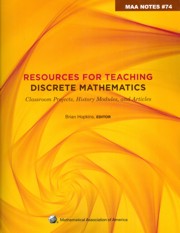Book contents
- Frontmatter
- Introduction
- Dedication
- Contents
- I Classroom-tested Projects
- II Historical Projects in Discrete Mathematics and Computer Science
- Introduction
- Binary Arithmetic: From Leibniz to von Neumann
- Arithmetic Backwards from Shannon to the Chinese Abacus
- Pascal's Treatise on the Arithmetical Triangle: Mathematical Induction, Combinations, the Binomial Theorem and Fermat's Theorem
- Early Writings on Graph Theory: Euler Circuits and The Königsberg Bridge Problem
- Counting Triangulations of a Convex Polygon
- Early Writings on Graph Theory: Hamiltonian Circuits and The Icosian Game
- Are All Infinities Created Equal?
- Early Writings on Graph Theory: Topological Connections
- A Study of Logic and Programming via Turing Machines
- Church's Thesis
- Two-Way Deterministic Finite Automata
- III Articles Extending Discrete Mathematics Content
- IV Articles on Discrete Mathematics Pedagogy
- About the Editor
Early Writings on Graph Theory: Topological Connections
from II - Historical Projects in Discrete Mathematics and Computer Science
- Frontmatter
- Introduction
- Dedication
- Contents
- I Classroom-tested Projects
- II Historical Projects in Discrete Mathematics and Computer Science
- Introduction
- Binary Arithmetic: From Leibniz to von Neumann
- Arithmetic Backwards from Shannon to the Chinese Abacus
- Pascal's Treatise on the Arithmetical Triangle: Mathematical Induction, Combinations, the Binomial Theorem and Fermat's Theorem
- Early Writings on Graph Theory: Euler Circuits and The Königsberg Bridge Problem
- Counting Triangulations of a Convex Polygon
- Early Writings on Graph Theory: Hamiltonian Circuits and The Icosian Game
- Are All Infinities Created Equal?
- Early Writings on Graph Theory: Topological Connections
- A Study of Logic and Programming via Turing Machines
- Church's Thesis
- Two-Way Deterministic Finite Automata
- III Articles Extending Discrete Mathematics Content
- IV Articles on Discrete Mathematics Pedagogy
- About the Editor
Summary
Introduction
The earliest origins of graph theory can be found in puzzles and game, including Euler's Königsberg Bridge Problem and Hamilton's Icosian Game. A second important branch of mathematics that grew out of these same humble beginnings was the study of position (“analysis situs”), known today as topology. In this project, we examine some important connections between algebra, topology and graph theory that were recognized during the years from 1845–1930.
The origin of these connections lie in work done by physicist Gustav Robert Kirchhoff (1824–1887) on the flow of electricity in a network of wires. Kirchhoff showed how the current flow around a network (which may be thought of as a graph) leads to a set of linear equations, one for each circuit in the graph. Because these equations are not necessarily independent, the question of how to determine a complete set of mutually independent equations naturally arose. Following Kirchhoff's publication of his answer to this question in 1847, mathematicians slowly began to apply his mathematical techniques to problems in topology. The work done by the French mathematician Henri Poincaré (1854–1912) was especially important, and laid the foundations of a new subject now known as “algebraic topology.”
This project is based on excerpts from a 1922 paper in which Oswald Veblen [1880–1960] shows how Poincaré formalized the ideas of Kirchhoff. An American mathematician born in Iowa, Veblen's father was also a mathematician who taught mathematics and physics at the State University of Iowa.
- Type
- Chapter
- Information
- Resources for Teaching Discrete MathematicsClassroom Projects, History Modules, and Articles, pp. 231 - 240Publisher: Mathematical Association of AmericaPrint publication year: 2009



